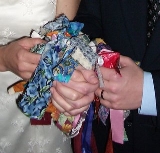
Handfasting
Overview
Handfasting is a traditional Europe
an ceremony of (temporary or permanent) betrothal or wedding
. It usually involved the tying or binding of the right hands of the bride and groom with a cord or ribbon for the duration of the wedding ceremony.
The term is derived from the verb to handfast, used in Middle
to Early Modern English
for the making of a contract of marriage. The term is originally from Old Norse
hand-festa "to strike a bargain by joining hands.".
Europe
Europe is, by convention, one of the world's seven continents. Comprising the westernmost peninsula of Eurasia, Europe is generally 'divided' from Asia to its east by the watershed divides of the Ural and Caucasus Mountains, the Ural River, the Caspian and Black Seas, and the waterways connecting...
an ceremony of (temporary or permanent) betrothal or wedding
Wedding
A wedding is the ceremony in which two people are united in marriage or a similar institution. Wedding traditions and customs vary greatly between cultures, ethnic groups, religions, countries, and social classes...
. It usually involved the tying or binding of the right hands of the bride and groom with a cord or ribbon for the duration of the wedding ceremony.
The term is derived from the verb to handfast, used in Middle
Middle English
Middle English is the stage in the history of the English language during the High and Late Middle Ages, or roughly during the four centuries between the late 11th and the late 15th century....
to Early Modern English
Early Modern English
Early Modern English is the stage of the English language used from about the end of the Middle English period to 1650. Thus, the first edition of the King James Bible and the works of William Shakespeare both belong to the late phase of Early Modern English...
for the making of a contract of marriage. The term is originally from Old Norse
Old Norse
Old Norse is a North Germanic language that was spoken by inhabitants of Scandinavia and inhabitants of their overseas settlements during the Viking Age, until about 1300....
hand-festa "to strike a bargain by joining hands.".
Unanswered Questions

